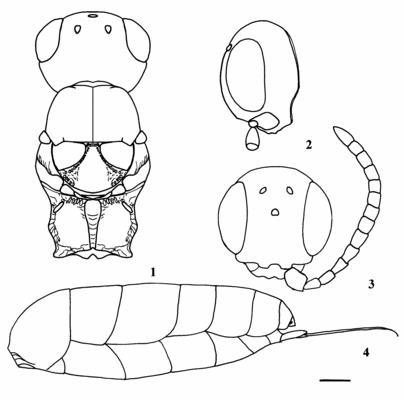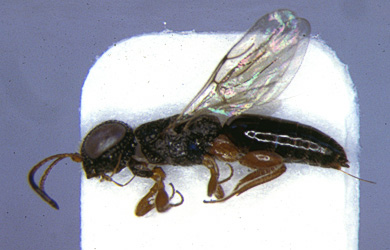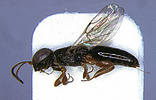Cryptalyra
Scott Richard Shaw


This tree diagram shows the relationships between several groups of organisms.
The root of the current tree connects the organisms featured in this tree to their containing group and the rest of the Tree of Life. The basal branching point in the tree represents the ancestor of the other groups in the tree. This ancestor diversified over time into several descendent subgroups, which are represented as internal nodes and terminal taxa to the right.

You can click on the root to travel down the Tree of Life all the way to the root of all Life, and you can click on the names of descendent subgroups to travel up the Tree of Life all the way to individual species.
For more information on ToL tree formatting, please see Interpreting the Tree or Classification. To learn more about phylogenetic trees, please visit our Phylogenetic Biology pages.
close boxIntroduction
Cryptalyra is a small genus with three rare species known only from South America. Cryptalyra plaumanni was described by Shaw (1987) from southern Brazil. Cryptalyra colombia was described from Colombia by Shaw (2002). Cryptalyra depressa, the most recently discovered species, was described by Azevedo and Tavares (2006).
Shaw (1990) inferred a sister-group relationship of Cryptalyra with the Oriental/Australasian genus Carminator, and placed both in the tribe Cryptalyrini. Three synapomorphies support this relationship: compact flagellomeres, loss of the forewing metacarpus vein, and loss of the hind wing RS vein.
Characteristics
Cryptalyra species can be distinguished from other megalyrids by their minute body size (4.6 mm or less), very short antenna, and exceptionally short ovipositor sheath (barely protruding beyond the apex of the metasoma). The ovipositor can be retracted into the body.


Cryptalyra depressa Azevedo and Tavares. © 2006 Magnolia Press - Celso Azevedo . 1. Dorsal view of head and mesosoma. 2. Lateral view of head. 3. Anterior view of head and antenna. 4. Lateral view of metasoma with ovipositor fully extended.
Discussion of Phylogenetic Relationships
Azevedo and Tavares (2006) suggested that Cryptalyra plaumanni and Cryptalyra depressa are sister-species because both species have the occipital carina curved toward the mandible, and the antenna only as long as the head.
References
Azevedo, C. O. and M. T. Tavares. 2006. A new species of Cryptalyra (Hymenoptera, Megalyridae) from Brazil with a key to the species of the genus. Zootaxa 1259:55-59.
Shaw, S. R. 1987. Three new megalyrids from South America (Hymenoptera: Megalyridae). Psyche 94(1-2):189-199.
Shaw, S. R. 1990. Phylogeny and biogeography of the parasitoid wasp family Megalyridae (Hymenoptera). Journal of Biogeography 17:569-581.
Shaw, S. R. 2003. A new Cryptalyra species from Colombia (Hymenoptera: Megalyridae). Zootaxa 248:1-4.
Title Illustrations

| Scientific Name | Cryptalyra colombia |
|---|---|
| Location | Colombia |
| Specimen Condition | Dead Specimen |
| Sex | Female |
| Life Cycle Stage | Adult |
| Size | 4.3 mm |
| Copyright |
© 2003 Scott Richard Shaw

|
About This Page
Scott Richard Shaw

University of Wyoming, Laramie, Wyoming, USA
Correspondence regarding this page should be directed to Scott Richard Shaw at
braconid@uwyo.edu
Page copyright © 2005 Scott Richard Shaw
All Rights Reserved.
- First online 18 February 2005
- Content changed 20 February 2007
Citing this page:
Shaw, Scott Richard. 2007. Cryptalyra. Version 20 February 2007 (under construction). http://tolweb.org/Cryptalyra/28843/2007.02.20 in The Tree of Life Web Project, http://tolweb.org/







 Go to quick links
Go to quick search
Go to navigation for this section of the ToL site
Go to detailed links for the ToL site
Go to quick links
Go to quick search
Go to navigation for this section of the ToL site
Go to detailed links for the ToL site